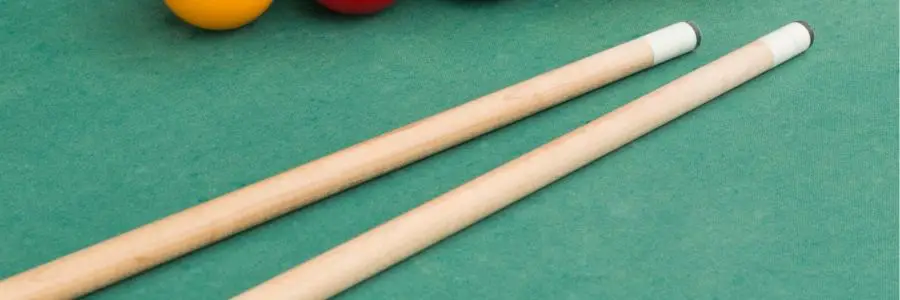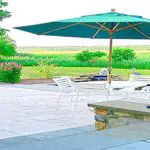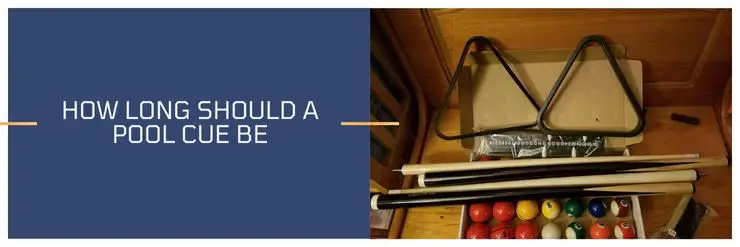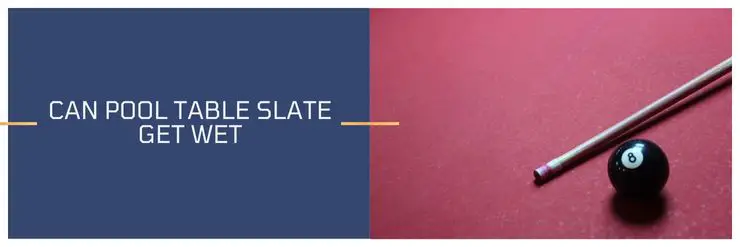When you are new to the game of pool, or even if you have been playing for a while, there are a few things that you need to know in order to improve your game. In this blog post, we will discuss how to choose a pool cue tip. There are many different types of tips available on the market, so it can be tricky to decide which one is right for you. We will go over the different types of tips and help you figure out which one is best for your style of play. So, whether you are just starting out or looking to upgrade your equipment, keep reading for some helpful advice on how to choose a cue tip.
There are a few things to consider when choosing a pool cue tip. The hardness of the cue tip is important. The type of tip is also important such as leather or layered and the size of the cue tip. Once you have your cue tip you will need to consider the shape you want your cue tip to be.
Things we will cover when for when you’re choosing a pool cue tip so you will know exactly how to choose a pool cue tip that’s right for you!
- Type of tip
- The hardness of the tip
- The shape of the tip
- Size of tip
Go through this guide to help you figure out the best tip for your game.
Types of tips for pool cues
The most common type of tip would be a leather tip, these come in two styles; a solid leather tip and a layered leather tip. For the most part, I would recommend these types of cue tips.
Other types of pool cue tips are screw-on tips, slip-on-tips and phenolic resin tips.
- Leather tip (solid)
- Leather tip (layered)
- Phenolic tip
- Screw-on tip
- Slip-on tip
If you are here because you are looking at how to choose a pool cue tip that will enhance your level of play, then disregard screw-on tips and slip-on tips. There is a place for these, but you won’t find them in a serious billiard player’s arsenal.
The other types of tips are to be glued onto your ferrule, and I would recommend these for the serious players.
The best and most common type of pool cue tip is a solid leather or layered leather cue tip.
Differences between a solid cue tip, layered cue tip, and a phenolic cue tip
When choosing a pool cue tip, thought needs to be given to the type of player you are. That will help decide the type of hardness, shape, and size. The type of tip you want for your playing cue is a solid or layered leather cue tip and a hard phenolic resin for your breaking cue.
Let’s take a look at some of the key differences between cue tips. I will only look at Leather tips and Phenolic tips as these are the main types of tips.
Leather tips are made from different types of skin with japanize pigskin being considered some of the best types of leather to use for making cue tips.
There are two types of leather cue tips:
- Solid leather cue tip
- Layered laminated cue tip
As the name suggests, a solid leather cue tip is made from one piece of solid leather.
A layered laminated cue tip is made from strips of leather laminated together to form a cue tip.
The other type of cue tip is a Phenolic tip, these are very hard tips ideal for breaking
Layered leather cue tip
Layered laminated tips are made using layers of leather compressed and stacked together, glued, and then pressed forming the cue tip.
Although more expensive than solid cue tips, they do have some advantages to compensate for their higher price tag.
Due to the way they are made they tend to hold their shape for longer and therefore less maintenance is required.
They also retain chalk better, applying more friction on the cue ball resulting in more control. With these factors combined, you get a much more consistent, controlled shot while striking the cue ball.
A good example of layered leather cue tips are the ones from Kamui (Amazon link), they are considered one of the best cue tips available.
For the advantages mentioned, layered tips are usually used by professional players.
Solid leather cue tip
A solid cue tip is made from a single piece of specially tanned leather that is cut to make a single pressed layer.
Ping skin or cowhide are common leathers used for cue tips.
Despite being cheaper than layered cue tips there are some noticeable qualities to a solid cue tip.
They produce a nice solid hit and they can be available in precise sizes which will match the diameter of your ferrule which would require less work to install it.
The issues with Solid leather tips are they will require more maintenance as they tend to mushroom more than layered tips.
This can become an issue as the more work you need to give a cue tip so it’s in good playing condition will slowly deteriorate the tip itself and result in it in becoming spongey.
A classic cue solid cue tip are the ones from Elk Master (Amazon link), highly regarded cue tips
These types of cue tips are usually found on house cues.
Phenolic resin cue tips
Phenolic resin cue tips are excellent for breaking and jumping because they are extremely hard.
On a durometer, which measures how hard different materials are on a scale from 1 – 100. Phenolic cue tips can reach the 99 mark, meaning they are extremely hard.
What this means is there is less cushion maximizing the transfer of energy onto the cue ball. The energy transfers into speed and power when struck, hence why they are ideal for breaking with.
An example of a phenolic resin cue tip is the one from Elite (Amazon link)
Being hard in nature, they naturally hold their shape are extremely durable, but for this reason, they are not ideal for playing with, just for jumping and breaking with.
| Phenolic tip | Solid cue tip | Layered tip | |
| Cost | High | Cheaper | High |
| Material | Phenolic | Leather | Leather |
| Build | compressed Phenolic resin | Single piece of leather | Layers of leather laminated |
| Maintenance | Hardly any | A lot | Some |
| Ideal for | Breaking | Playing | Playing |
| Retain chalk | Bad | Ok | Best |
| Playability | N/A | consistent | more consistent |
Pool cue tip hardness
cue tip hardness is divided into 3 categories, soft, medium, and hard. A soft tip gives more cue ball spin and is ideal for beginners. A medium tip provides good control and is a good choice for most players. Hard tips offer more power and are best for advanced players.
how to choose a pool cue based on hardness is important for your game. You’ll need to consider which cue tip hardness you would like.
The ranges go from extra soft to extra hard, with each level having a different result in terms of cue ball control, energy transfer and spin.
The hardness of a cue tip is measured on a durometer which measures the density of the cue tip. It starts at 1, which has the softest density and ends on 100 which has the hardest.
If you want to know the hardness of a particular cue tip then its possible to check out a cue tip hardness chart that lists most of the popular cue tips and their hardness score. Check out a cue tip hardness chart here
Which cue tip hardness is best for you
Pick what type of player you are below and that will give you a good idea of what type of cue tip hardness is best for you.
- A softer pool cue tip: Will allow you to control the cue ball more.
- A medium cue tip: Will give you a good balance of control and power
- A hard cue tip: Will give you more power but less control
SOFT POOL CUE TIPS
- Finesse shots
- Positional with draw & English
- Control the cue ball
- Check out this Kamui soft cue tip (Amazon link)
MEDIUM CUE TIPS
- Play with Some power shots
- Also, play with finesse
- Try to control cue ball
- Check out this Kamui medium cue tip (Amazon link)
HARD POOL CUE TIPS
- Want cue ball control & power
- Transfer maximum energy
- Want less tip maintenance
- Check out this Kamui hard cue tip (Amazon link)
Below is a Kamui tip hardness chart.
- Super soft Kamui tip hardness chart: about 68 on a durometer test
- Soft Kamui tip hardness chart: about 72 on a durometer test
- Medium Kamui tip hardness chart: about 75 on a durometer test
- Hard Kamui tip hardness chart: about 82 on a durometer test
Here is a guide on how to choose a pool cue hardness. – Different hardness levels play like this:
A softer cue tip should grip better to the cue ball as when struck, as the longer period the tip is in contact with the cue ball. This, and the fact they hold chalk better, gives the cue ball its extra control and spin making it easier to add draw or english to your shots. These types of cue tips generally require more maintenance as they are softer and will harden with continued use.
A medium cue tip is somewhere between a soft and a hard cue tip. Therefore it has some of the qualities of both types. They keep their shape better than softer tips and hold chalk well.
A harder cue tip produces more energy when the cue ball is struck. Less of the cue tip is on the surface of the cue ball for less of the time, which transfers the maximum amount of energy. These types of tips require less grooming and maintenance and the hardest of these types of tips are perfect to braking with – hence why a lot of phenolic tips are used for breaking with.
It’s important to note that it’s still possible to get all that extra control and spin from a hard tip. It just requires a lot of practice. Using a softer tip gives you that control easier, but the same results are possible with tips of a harder density, that’s why a lot of pros choose a harder tip.
Cue tip shape nickel or dime
Another important consideration when choosing a pool cue tip is how to shape it, most people will either choose a tip with a radius of a nickel or a dime when shaping their cue tip. What is meant by this is when the tip is shaped, the radius of the tip is fashioned into the radius of a nickel or dime.
The idea is with a nickel-shaped cue tip, there is a larger point of contact on the cue ball than with a dime. As the radius of a nickel is larger than the radius of a dime. With a smaller contact point on the cue ball and with that contact point being further from the cue ball center, more spin is produced.
The type of shape you prefer is really a matter of trial and error until you find one that works best with your style of play.
Another consideration would be, do you want a flatter surface to your cue tip or a more rounded, dome-like tip.
You need to visualize a flatter cue tip and a rounder dome-like tip being cued at the same point on a cue ball.
The flatter cue will make contact with the cue ball closer to the center of the ball, which will produce less spin.
As mentioned, a rounder cue tip will make contact with the cue ball further away from the center of the ball, which will produce more spin.
Do you need to shape a brand new cue tip
When you buy a brand new cue tip you’ll find it has a flat surface.
In order to get the most out of your cue tip, you will need to make it flush to your ferrule, you can do this by using a tip tool or Stanley blade, and shaping it.
Rounding off the cue tip will help with ball control and also help to prevent miscues.
You will also want to taper the cue tip so that it is narrower at the top than the bottom. This will help with adding spin to your shots.
Shaping a cue tip is not difficult, but it can take some practice. If you are unsure how to do it, then it is best to take your cue tip to a local pool hall or pro shop and get them to do it for you.
Which cue tip size you’ll need
When choosing a tip some thought needs to be given to the size you want. For most layered tips you will need to consider a cue tip with a diameter of 13mm or 14mm.
A lot of solid leather cue tips can come in a range of sizes that can fit your ferrule perfectly.
The diameter of your pool cue tip should be the same size as your cue shaft. You can find cue tips in 13mm, 14mm, and even larger and shorter diameters.
The pool cues ferrule, where the cue tip sits will determine the diameter of your cue tip. Most ferrules are .580 inches, so a 13mm cue tip would be the best size for most cues.
If you purchase a pool cue tip with a larger diameter than your cues ferrule then you can reduce the size of the cue tip using a tip tool or Stanley blade.
A lot of cues come with a diameter of 13mm as standard. If in doubt, pick a larger tip, perhaps a 14mm and follow my guide on how to replace a cue tip to learn how to fit and cut it correctly.
What’s the best cue tip
There is no definitive answer as to what the best cue tip is. It all comes down to personal preference. Some people prefer a softer cue tip, while others prefer a harder cue tip. The Kamui Clear Black Cue Tip is very popular among pool players because it provides a great feel and control. Many high-level and professional pool players swear by Kamui.
There are other top-rated cue tips such as Moori, Predator Victory, Tiger Everest, and Zan Hybrid Max – all are excellent and highly rated.
Check out my best cue tips here
If you are choosing a pool cue tip and want a top-rated one then any of the ones mentioned are ideal.
What is the best pool cue tip for draw English
Softer cue tips are considered easier to play draw and English shots with, and the gripping performance of Kamui are frequently chosen.
The soft Kamui Clear Black Cue Tip (Amazon link) is a popular choice as it grips to the cue ball extremely well, causing a lot of friction which in turn produces great draw shots.
If you use a softer cue tip you will find it easier to produce draw as there is more contact time on the cue ball and therefore it will produce more friction, making draw shots much easier than if you used a hard cue tip.
If you want to check out my best cue tips for English then click the link for the best on the market.
Conclusion
Choosing a pool cue tip can be confusing, there are plenty out there and they all look the same. Now you understand some of the differences it should help you determine which type of pool cue tip is best for you.
At the end of the day, you will need to try a lot of different types until you find the right one, but now you have a guide to figure out the differences between the different types of cue tips it should help you speed the process up.
Choosing a pool cue tip is not done over night, it will take a few years of trial and error before you find the one that is best suited to your game.
Rob is an avid player and fan of all cue sports, particularly 8-ball, and snooker. He has competed in a few local 8-ball tournaments and although he is not a professional, he can compete with the best of them.










